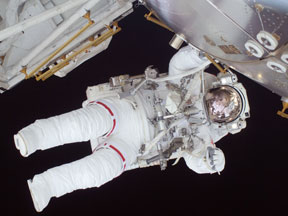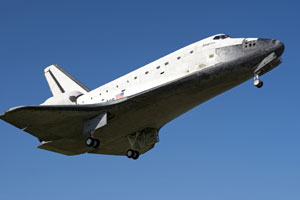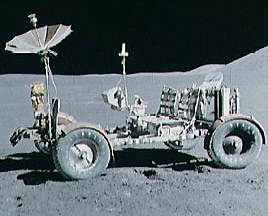There are many types of dangerous radiation in space. Astronauts must be careful to remain safe and healthy. Spacewalks are especially dangerous times for radiation exposure.
Click on image for full size
Image courtesy of NASA.
Radiation Dangers to Astronauts
Astronauts are exposed to many different types of dangerous radiation in space. Space agencies, like NASA, must carefully monitor the radiation exposure of astronauts to make sure they remain safe and healthy.
Earth's atmosphere and magnetic field both serve as radiation shields for those of us who are on Earth's surface. Most piloted space missions (ones with astronauts aboard) "fly" in Low Earth Orbit (LEO), slightly above Earth's atmosphere. Astronauts in LEO are still within the protective bubble of Earth's magnetosphere, which deflects many types of particle radiation. Astronauts are outside of the protection of our atmosphere, however, and are thus at greater risk of exposure to high-energy electromagnetic radiation including ultraviolet "light", X-rays, and gamma rays. Even in LEO, astronauts must take precautions to deal with radiation, especially when they are outside on spacewalks or when "solar storms" are brewing.
Trips by astronauts to the Moon, Mars, and asteroids will provide us with bigger challenges protecting astronauts from radiation as they leave the protection of Earth's magnetosphere behind. The Moon offers almost no protection, as it lacks both an atmosphere and a magnetic field. Mars has a very thin atmosphere and a weak, regional magnetic field in some locations. Early Mars bases may be built at low elevation (at the bottom of the "deepest" parts of the atmosphere) locations that are also within a regional magnetic field, in order to take advantage of as much natural radiation shielding as possible.
You might also be interested in:

The International Space Station (ISS) is a large space station that orbits Earth. There are astronauts and cosmonauts living onboard the ISS right now. The ISS isn't completely finished, though. New sections
...more
Astronauts are exposed to many different types of dangerous radiation in space. Space agencies, like NASA, must carefully monitor the radiation exposure of astronauts to make sure they remain safe and
...more
The space shuttle Atlantis finished its last flight when it landed on May 26, 2010. NASA is retiring the whole fleet of space shuttle orbiters by the end of 2010. Discovery and Endeavor are the other two
...more
The Hubble Space Telescope (HST) was one of the most important exploration tools of the past two decades, and will continue to serve as a great resource well into the new millennium. The HST found numerous
...more
Driven by a recent surge in space research, the Apollo program hoped to add to the accomplishments of the Lunar Orbiter and Surveyor missions of the late 1960's. Apollo 11 was the name of the first mission
...more
Apollo 12 was launched on Nov. 14, 1969, surviving a lightning strike which temporarily shut down many systems, and arrived at the Moon three days later. Astronauts Charles Conrad and Alan Bean descended
...more
Apollo 15 marked the start of a new series of missions from the Apollo space program, each capable of exploring more lunar terrain than ever before. Launched on July 26, 1971, Apollo 15 reached the Moon
...more














